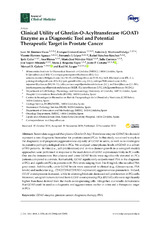Clinical Utility of Ghrelin-O-Acyltransferase (GOAT) Enzyme as a Diagnostic Tool and Potential Therapeutic Target in Prostate Cancer
Autor
Jiménez-Vacas, J.M.
Gómez Gómez, Enrique
Montero-Hidalgo, Antonio J.
Herrero-Aguayo, V.
L-López, Fernando
Sánchez-Sánchez, Rafael
Guler, Ipek
Blanca, Ana
Méndez-Vidal, María José
Carrasco, Julia
López-Miranda, José
Requena-Tapia, M.J.
Castaño, Justo P.
Gahete Ortiz, Manuel D.
Luque, Raúl M.
Editor
MDPIFecha
2019Materia
GOAT-enzymeProstate cancer
Diagnosis
Therapy
PSA
METS:
Mostrar el registro METSPREMIS:
Mostrar el registro PREMISMetadatos
Mostrar el registro completo del ítemResumen
Recent data suggested that plasma Ghrelin O-Acyl Transferase enzyme (GOAT) levels could represent a new diagnostic biomarker for prostate cancer (PCa). In this study, we aimed to explore the diagnostic and prognostic/aggressiveness capacity of GOAT in urine, as well as to interrogate its putative pathophysiological role in PCa. We analysed urine/plasma levels of GOAT in a cohort of 993 patients. In vitro (i.e., cell-proliferation) and in vivo (tumor-growth in a xenograft-model) approaches were performed in response to the modulation of GOAT expression/activity in PCa cells. Our results demonstrate that plasma and urine GOAT levels were significantly elevated in PCa patients compared to controls. Remarkably, GOAT significantly outperformed PSA in the diagnosis of PCa and significant PCa in patients with PSA levels ranging from 3 to 10 ng/mL (the so-called PSA grey-zone). Additionally, urine GOAT levels were associated to clinical (e.g., Gleason-score, PSA levels) and molecular (e.g., CDK2/CDK6/CDKN2A expression) aggressiveness parameters. Indeed, GOAT overexpression increased, while its silencing/blockade decreased cell-proliferation in PCa cells. Moreover, xenograft tumors derived from GOAT-overexpressing PCa (DU145) cells were significantly higher than those derived from the mock-overexpressing cells. Altogether, our results demonstrate that GOAT could be used as a diagnostic and aggressiveness marker in urine and a therapeutic target in PCa.

